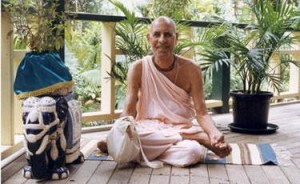PURE BHAKTI TV , BHAKTI YOGA

> A. C. Bhaktivedanta Swami Prabhupada <
Bhakti (DevanÄgarÄ«: à¤à¤à¥à¤¤à¤¿, Sanskrit: devotion, or portion) in practice signifies an active involvement by the devotee in divine worship. The term is often translated as „devotion“, though increasingly „participation“ is being used as a more accurate rendering, since it conveys a fully engaged relationship with God. One who practices bhakti is called a bhakta, while bhakti as a spiritual path is referred to as bhakti marga, or the bhakti way. Bhakti is an important component of many branches of Hinduism, defined differently by various tradtions and schools.
Bhakti emphasises devotion and practice above ritual. Bhakti is typically represented in terms of human relationships, most often as beloved-lover, friend-friend, parent-child, and master-servant. It may refer to devotion to a spiritual teacher (Guru) as guru-bhakti, to a personal form of God,or to divinity without form (nirguna). Different traditions of bhakti in Hinduism are sometimes distinguished, including: Shaivas, who worship Shiva and the gods and goddesses associated with him; Vaishnavas, who worship forms of Vishnu, his avataras, and others associated with; Shaktas, who worship a variety of goddesses. Belonging to a particular tradition is not exclusiveâdevotion to one deity does not preclude worship of another.
The Bhagavad Gita is the first text to explicitly use the word „bhakti“ to designate a religious path,which the Bhagavata Purana develops more elaborately. The so-called Bhakti Movement saw a rapid growth of bhakti beginning in Southern India with the Vaisnava Alvars (6th-9th century CE) and Saiva Nayanars (5th-10th century CE), who spread bhakti poetry and devotion throughout India by the 12th-18th century CE. Bhakti influence in India spread to other religions, Â coloring many aspects of Hindu culture to this day, from religious to secular, and becoming an integral part of Indian society.
Bhakti Yoga
The Bhagavad Gita introduces bhakti yoga in combination with karma yoga and jnana yoga, while the Bhagavata Purana expands on bhakti yoga, offering nine specific activities for the bhakti yogi.Bhakti in the Bhagavad Gita offered an alternative to two dominant practices of religion at the time: the isolation of the sannyasin and the practice of religious ritual.Bhakti Yoga is described by > Swami Vivekananda < as „the path of systematized devotion for the attainment of union with the Absolute“. In the twelfth chapter of the Gita Krishna describes bhakti yoga as a path to the highest spiritual attainments. In the ninth chapter, he says,
Fill thy mind with Me, be My devotee, sacrifice unto Me, bow down to Me; thus having made thy heart steadfast in Me, taking Me as the Supreme Goal, thou shalt come to Me. (B-Gita 9.34)
Shandilya and Narada produced two important Bhakti texts, the Shandilya Bhakti Sutra and Narada Bhakti Sutra. They define devotion, emphasize its importance and superiority, and classify its forms.
> Meet Centro Studi Bhaktivedanta at facebook <
> Meet Srila Prabubhada at facebook <
> Meet ISKCON Friends at facebook <
> Meet Swami Vivekananda Groups at facebook <
Â
Comments are closed.